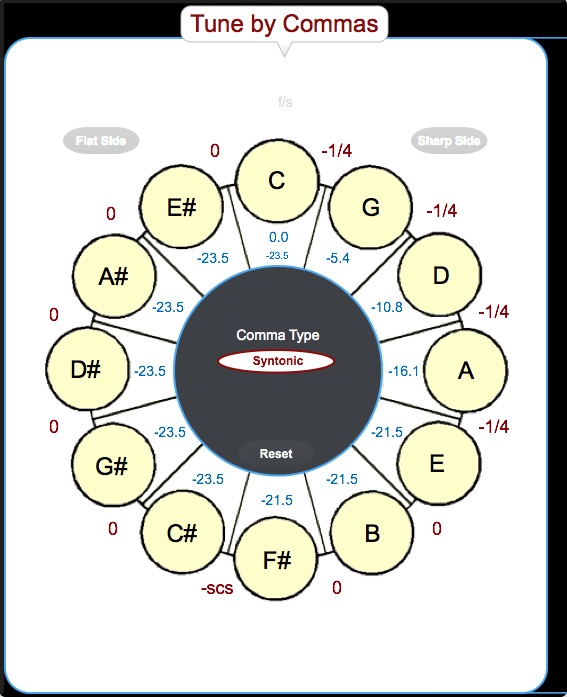bitSuite
Example #2: Kirnberger III
The idea of the Kirnberger III temperament is that C to E is tuned as a just major 3rd, and the fifths between (C-G-D-A-E) are compressed that so each is detuned the same amount, a quarter comma:

The rest of the fifths are tuned perfectly, hence the zeros, other than the one C#/F# fifth, which has a very small fraction ("scs"), described below.
In Kirnberger III, the comma type will automatically change from “Pythagorean” to “Syntonic," since we are building the temperament around a just-tuned major third. The Syntonic comma is 21.5 cents, versus the Pythagorean of 23.5 cents. A Syntonic comma is the difference between just 3rd (a 5/4 ratio) and Pythagorean 3rd (the result of stacking fifths); by splitting that difference across the four fifths leading to E, we create a C/E third that is just.
Regarding commas, different labels are applied to different commas to avoid mathematical confusion over long musical distances. Though the difference between Pythagorean and Syntonic is only 2 cents, this discrepancy would add up over the length of an entire keyboard. Generally, tunings which favor thirds will use the Syntonic comma. The presets in bitTemper will automatically choose the right comma based on what type you’re doing, or the comma type can be changed by clicking at the center of the Comma panel. There are different varieties of commas – more information can be found here.
In practice, tuners don’t differentiate between the Pythagorean and Syntonic commas when tuning a keyboard, because the 2 cent difference is so small and basically gets distributed throughout the keyboard naturally, since it’s impossible to tune fifths absolutely perfectly. However, to make the numbers work in bitTemper, we put that 2-cent difference, or scisma (“scs” in the comma menus), between one of the fifths, to compensate for the difference between the two commas.
Put another way, the -¼ between each of the fifths in Kirnberger III is really one quarter of a Syntonic comma, so that C-E third is a just 5/4 third, and the -scs closes the gap that is left over, but in practice a tuner would simply refer to that Syntonic comma fraction as a “quarter-comma” without indicating which kind, because it’s too small to worry about.
To actually implement this temperament, a tuner would first tune that C/E third just, which is reasonably easy to hear and tune accurately (try it yourself!). Then, the tuner would tune the 4 fifths in between C and E so they sounded similarly flat. Then, the tuner would continue from E clockwise for 2 or 3 fifths, tuning them perfectly. Finally, s/he would tune perfect fifths counter-clockwise from C until closing the gap. After gradually adjusting all of these fifths to make them as perfect as possible, we'd end up with this temperament, and that scisma would essentially vanish into small errors distributed across all of the fifths.
There are literally hundreds of different temperaments like this one, and techniques for actually creating them on a keyboard. Again, visit Carey Beebe's website and follow his links to Resources/Technical Library/Temperament to learn how to do many of these, and try them with bitTemper.